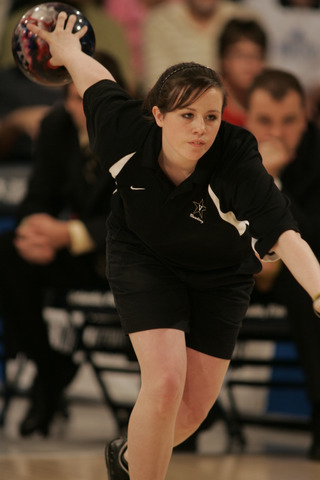April 15, 2007
Read Previous Columns in the Commodore Notebook Archive
Championship Recap: Vanderbilt 4 Maryland Eastern Shore 3
 |
|
| Tournament MVP Josie Earnest iced the championship with two crucial strikes in the tenth frame of the final game. |
So Vanderbilt won the national bowling championship. Did anyone notice?
In Columbia, South Carolina Steve Spurrier had just finished his team’s Spring Football Game and was in the locker room with former Vanderbilt administrator Chris Wyrick, spinning through the television channels when he paused.
“Hey Wyrick, didn’t you come from Vanderbilt?” said the crafty coach.
“Ya, why?” replied the former National Commodore Club director.
“Because they are on here going for the national championship.”
And the two sat there watching the Commodores win it all.
In the hour after the seventh and final game that produced the school’s first NCAA team championship, Coach John Williamson received 45 text messages on his cell phone, many from people he didn’t know. They were proud Vanderbilt alumni, students, staff, friends and sports fans. Former baseball stars Jonathon Douillard and Cesar Nicolas text messaged after watching.
Chancellor Gordon Gee was among the first to get through via telephone to Williamson. It was evident from his comments and questions that he had been closely following the events in the Orlando suburb of Apopka.
Not long after came congratulatory calls from various Vanderbilt Vice Chancellors and other well-wishers. The 29-year old coach was interviewed by a variety of news media including Vanderbilt play-by-play announcer Joe Fisher during a rain delay in the Commodores’ baseball game in Lexington.
One of Williamson’s biggest boosters is Tim Corbin, whom Williamson worked under for two years as the baseball operations director. Likewise, there are few people more excited about the baseball program than Williamson.
It was Tim Corbin who opened Williamson’s eyes to a wide variety of winning habits, including hard work and preparation, the insights into successful recruiting, the importance of good team discipline and morale and how to effectively interact with the public and media.
It was Tim Corbin who talked to the bowlers on the eve of their departure to the NCAA tournament. He brought them to the baseball complex and explained the importance of visualization; “you have to be able to see yourself winning” he told them. He completed his talk by hauling out one of his favorite video clips – the final two minutes of the 1980 United States Olympic Hockey Team’s “Miracle on Ice.”
All this, and more, over a sport that often struggles for a public image?
Yes. Because people in the business of competing realize that competition is competition.
For most of us whose sum total knowledge of bowling consists of renting a pair of shoes and finding a ball in the rack on a weekend church outing, I can assure you that the sport is every bit as demanding and complex as, say, golf. If you hear two top bowlers talking shop, I dare say you won’t even understand what they are talking about.
But are bowlers really athletes?
Vanderbilt’s bowlers spend two days a week in the Strength and Conditioning Center under the watchful eye of Tasha Weddle, who says the bowlers would outshine some of the other varsity teams that the public might reason are more “athletic.”
Put it this way: these bowlers can throw 15-pound balls all day long and never tire. Some of the sport’s critics would have to sit down after two games and would be sore for a week.
But there are very few “big name” schools sponsoring bowling. Right?
True. The sport cannot pick and choose which universities sponsor the it, although Tulane adds the sport in 2010 and Memphis has also announced bowling will join its varsity menu soon. Nebraska has been a power since the sport was recognized by the NCAA.
But don’t be fooled by the Maryland Eastern Shores and New Jersey City Universities of the bowling universe. They are attracting the top high school bowlers in the country – the same way Texas, Ohio State and Southern Cal harvest top gridiron talent.
Doesn’t the main-line media relegate the sport to the small print section?
Of course, it is much more interested in following the exploits of Pacman because, unfortunately, our sporting society can’t get enough of such stuff. But just because some editor concerned about falling subscription numbers doesn’t feel a need to give collegiate bowling major attention doesn’t mean the sport doesn’t merit attention or have value.
In fact, in the state of Tennessee bowling is the fastest growing participant sport. In the northern Rust Belt states, bowling has long been a mainstay and accordingly a majority of the top talent comes from the northeast and upper Midwest. Some day soon, Williamson hopes a home grown product is wearing Black and Gold.
But for right now, let’s just agree on a few things. One, Vanderbilt now has its first national championship trophy in the 134 years of its existence. Two, this Commodore team – which a year ago had a 3.49 team grade point average, has done wonders to promote and educate the public about the sport. Three, it is a heck of a lot of fun to win.



